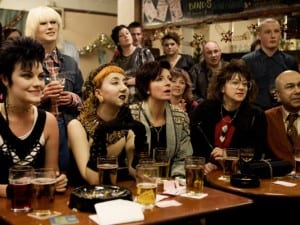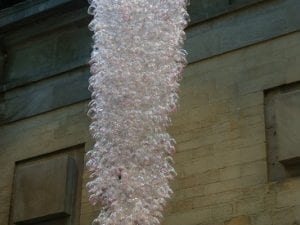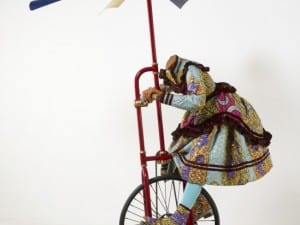Since 2003, Fiona Bradley has been the Director of The Fruitmarket Gallery in Edinburgh. Before then, Bradley was a curator at Tate Liverpool and the Hayward Gallery. She was responsible for a variety of exhibitions, including the first British exhibitions of the work of Rachel Whiteread and Andreas Gursky. She emphasises the importance of new work in the context of a consistent and developing artistic practice.
www.fruitmarket.co.uk
The gallery aims to make contemporary art accessible; without underestimating audiences, what are the gallery’s overriding goals?
Everything we do here starts with the art. At the moment, we’re installing the Johan Grimonprez show. He’s an incredibly complex artist and it’s a show that is time-based with several long films included. We look at it from this angle; imagine you’re a person who doesn’t know who Johan Grimonprez is, what do you need to know in order to understand the art? Or imagine, you’re somebody who’s seen absolutely every work Johan Grimonprez has ever made and you’re excited to see it in your home city, what do you need there? And so we offer a layered approach to interpretation. I think sometimes people think that contemporary arts is aiming to pull the wool over their eyes, and what we want to do is rehumanize it.
Your programmes are engaging, you show a range of Scottish and international artists, can you give me an idea about the curatorial breakdown?
We show between four and five exhibitions per year. Usually there’s a group show and then another is historic. With the remaining slots, one will be for a Scottish artist and the other for an international artist. The international aspect of the gallery is very important, both in the sense of bringing international artists, on one hand we introduce international artists to the local audience but also to make the Fruitmarket itself an international platform, when we’re showing a Scottish artist here, they’re showing on the international scale. It’s not just that we make shows with Scottish artists and we send those abroad (although we do that as well), it’s important that when a Scottish artist is shown here they’re entered into an international context.
Your current show is Johan Grimonprez, how do you feel his films chart the rise of a culture of fear, essentially making that emotion a commodity?
Johan is a politically engaged artist and for me it’s very important that contemporary art analyses the culture in which we live. When Dial H-I-S-T-O-R-Y was first made, it was pre-9/11, but that film has grown in really interesting ways. It’s incredibly relevant now, it’s a film about aeroplane hijacking, and how dependant we are on aeroplanes these days, and it’s also about the media. I first saw Double Take in Basel (2008). It’s the most amazing film about how Cold War politics have seeped into post-Cold War politics and how we create an identity, which is to do with our national identity. Although on the face of it, his films are long and can be quite hard subjects, they are utterly compelling.
How do you feel this theme is being played out and other artists are approaching this concept of a culture of fear?
We have shown Willie Doherty, who is engaged in politics and the politics of nationhood. One of the things to aspire for is art that makes itself, as you look at it. Art like Johan’s, which has its finger on the pulse to such an extent, does remake itself. I wandered around the gallery saying “remember when Johan started working,” I think the earliest working show was the early 1990s; Youtube wasn’t there and for him, there was an idea that you’re in control and juxtapositions happen because you’re channel hopping. Now that’s imbedded in how we experience the world, and when something happens, we go on the internet and we will get as many different views as possible, and even when the planes went into the Twin Towers, it wasn’t the internet we jumped on, it was the telly. You know, it sounds ridiculous, but even in 2001 the internet wasn’t quite what it is today, we didn’t have it on our mobile phones.
Do you feel there’s anything different happening in Edinburgh compared with London, for example?
Edinburgh is very energetic, and particularly in Glasgow, artists who trained here stay here. Artists from elsewhere come here because the art scene is thriving. That makes it a wonderful place to work, because there is a local audience of internationally recognised artists. Artists are your first audience; we make the programme for them, as much as much as we do for audiences who are not artists. Edinburgh is fantastic because it is an international centre; it’s the capital of Scotland. We have Edinburgh International Festival, and a lot of people look to Edinburgh as a cultural centre. That’s a huge bonus for us.
Congratulations on being invited to curate Scotland Venice 2011; can you give me a preview?
It’s very early days for Venice. We are working with Karla Black, who’s an artist that we have been interested in for a long time, she had a beautiful show at Inverleith House earlier this year, and showing her in Venice is an absolutely fantastic thing to do. I can say very little because we are going on our first site visit with Karla at the end of the month.
What is your programme for the rest of the summer, and future plans?
After the Johan Grimonprez show we have a big project with Martin Creed, who will be making a new commission. We are focusing on the element of Martin’s work that is to do with adding and subtracting by degrees. The work at the gallery involves turning the central staircase into a synthesizer. At the same time, he’s working on a work of public sculpture on the historic Scotsman Steps. Later this year, he’s going to resurface the steps in a 104 different types of marble from around the world. Martin will also show his ballet, commissioned by Sadler’s Wells and Frieze Music for Frieze and in October it will open at the Traverse Theatre. The ballet is about moving up and down the musical scale, moving up and down the five positions of ballet. Conceptually it all ties in.





